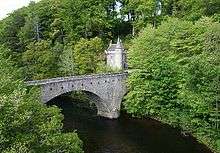Bridge of Avon
The Bridge of Avon is a bridge over the River Avon at Ballindalloch in Moray, Scotland, built between 1800 and 1801 by George Burn.[1][2] The bridge is mainly rubble-built, with an abutment on the south bank, and a pier with a cutwater on the north bank, of tooled ashlar.[3] It crosses the river in a single wide segmental arch, with a smaller flood arch on the north bank.[4]
Bridge of Avon | |
|---|---|
 The Bridge of Avon at Ballindalloch | |
| Coordinates | 57°24′22″N 3°21′39″W |
| Carries | Pedestrians (formerly road traffic) |
| Crosses | River Avon |
| Heritage status | Category A listed building |
| Characteristics | |
| Material | Masonry |
| History | |
| Architect | George Burn |
| Construction start | 1800 |
| Construction end | 1801 |
The south spandrel bears two plaques. The upper plaque records the date of the bridge's construction and its architect's name, and the lower plaque records the height reached by the waters in the catastrophic floods of August 4, 1829, known as the Muckle Spate,[4] which destroyed numerous other bridges in Moray.[5]
The bridge was designated a Category A listed building in 1972.[3] It is no longer open to vehicular traffic, having been bypassed by a modern concrete structure that now carries the A95 over the river, but can still be used by pedestrians.[2]
References
- "Basic Site Details - Bridge of Avon". Dictionary of Scottish Architects. Dictionary of Scottish Architects. Retrieved 7 July 2019.
- "Bridge of Avon". CANMORE. Historic Environment Scotland. Retrieved 5 July 2019.
- Historic Environment Scotland. "Ballindaloch, Bridge of Avon over River Avon (Category A) (LB8462)". Retrieved 5 July 2019.
- Walker, David W.; Woodworth, Matthew (2015). The Buildings of Scotland - Aberdeenshire: North and Moray. New Haven: Yale University Press. pp. 473–474. ISBN 9780300204285.
- Walker, David W.; Woodworth, Matthew (2015). The Buildings of Scotland - Aberdeenshire: North and Moray. New Haven: Yale University Press. p. 452. ISBN 9780300204285.